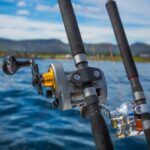Your fishing line is one of the most critical parts of your tackle box. While some fishermen prefer to have many different kinds of lines, others only want one line for all of their fishing purposes. However, the correct fishing line plays a significant part in your fishing experience. Many fly fishers wonder if they can use regular fishing lines for all their purposes, including tippets when fly fishing.
You can use a regular fishing line as a tippet when you fly fish. However, it would be best to consider factors like the water and weather conditions. While a regular fishing line is not as invisible as a tippet line, it is strong enough to handle the same task.
There are many different types of fishing, and anglers have their preferences as to which they prefer. However, fly fishing is an all-time favorite among many fishermen. Regular fishing line or tippet line, it doesn’t matter which you use. You can always enjoy your trips if you have the correct equipment that suits your fishing needs.
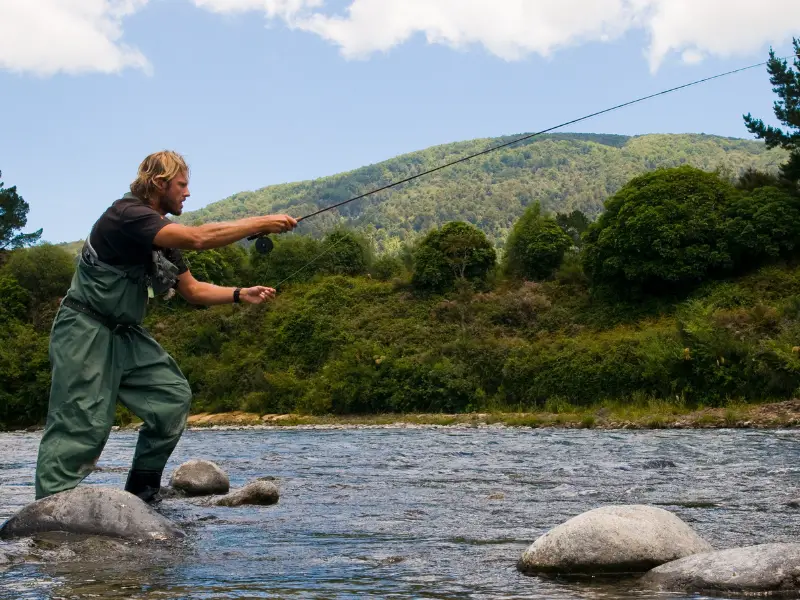
Fly Fishing With Regular Fishing Line As Tippet
You can use a regular fishing line as a tippet when you fly fish. Since the tippet line is smooth and almost invisible, it has excellent knot strength and flexibility. However, with a regular fishing line, you might lose some strength and agility in the water. Most tippet fishing lines consist of either nylon monofilament or fluorocarbon. A traditional fishing line made from monofilament should give no problems during your fly fishing trip.
Some anglers may not consider regular fishing lines the best option, but it is sufficient for most fishing trips. If your regular fishing line consists of monofilament, you will have a better chance for your line not to snap and to move better in the water. In addition, you should also consider that fly fishing requires more force than regular fishing. Therefore, you should ensure your line type is strong enough to support that force.
Tippet lines usually come on a spool, which will make it easier for you to pull off the length you need for your tippet. However, tippet lines can be more costly, which usually encourages anglers to use regular fishing lines. Still, many find the price worth it due to the increased fly fishing success they encounter.
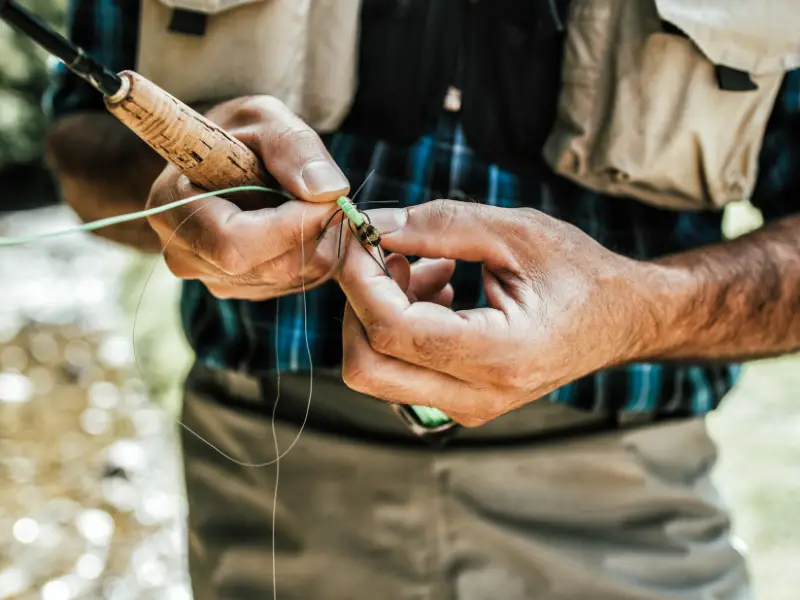
Benefits Of Using Regular Fishing Line As A Tippet
While many prefer not to use regular fishing lines as a tippet when fly fishing, there are a few benefits you should consider when you come to the choice of tippet lines. A regular fishing line can prove to be sufficient in some cases. Here are the benefits of using regular fishing line as a tippet:
- Cost efficiency – A regular fishing line is more affordable in most cases compared to specialty tippet lines. When you have a tight budget, a regular line will be the better option. If you go through a lot of tippets during your fishing trips, regular lines can be the more cost-effective choice
- Availability – Since regular fishing lines are widely known, you can find them in almost every bait and tackle shop you come across. Whereas tippet lines might be more challenging to acquire. You might have to travel long distances to find specialty tippet lines for your fly fishing trip
- Versatility – If you want a fishing line available in a wide range of strengths and diameters, regular fishing lines are the best choice since they are versatile. You can get regular fishing lines to suit almost every fishing style and environmental condition. When you have a wide range of lines, you also better your chances of acquiring bigger and more rare fish
- Easy to handle – Regular fishing lines can be more convenient to work with compared to tippet lines. The line itself is stiffer and less prone to tangle, which makes it easier for you to fish and tie knots
- Durable lines – Regular fishing lines are often stronger than specialty tippet lines, depending on what line diameter you choose. The lines are more resistant to debris and wind, and they can give you an advantage when fishing around heavy cover and obstacles that may cut the lines
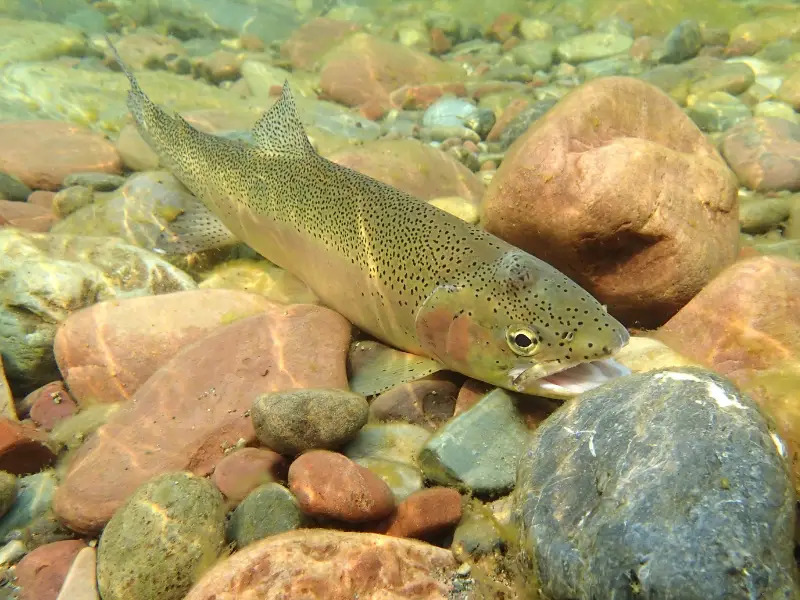
Drawbacks Of Using Regular Fishing Line As A Tippet
Regular fishing lines can have many drawbacks when fly fishing. Keep in mind that they might not perform as well in certain conditions when compared to specialty tippet lines. These are the drawbacks of using a regular fishing line as a tippet when fly fishing:
- Resistance – A tippet line is more resistant than regular fishing lines. You will have more resistance to rocks, debris, and fish teeth with the correct specialty fishing line
- Flexibility of the line – Specialty tippet lines are more flexible than regular fishing lines. The regular fishing line won’t move as freely in the water, and it can affect your presentation
- Knot strength – Regular fishing lines aren’t as strong as specialty tippet lines, so your knots may be less secure. Knot strength is essential to prevent breakage and secure your flies during fishing. Regular fishing lines can cause line breaks and lost flies
- Visibility in water – Regular fishing lines have more visibility in the water compared to specialty tippet lines. The line is not as clear or invisible as tippet lines, and it may scare the fish and reduce your chances of getting a bite
- Consistency of the diameter – Tippet materials are available in various diameters that match many “X” ratings. It may be more challenging to acquire standard fishing lines that precisely match these diameters, which may impair the performance of your fishing
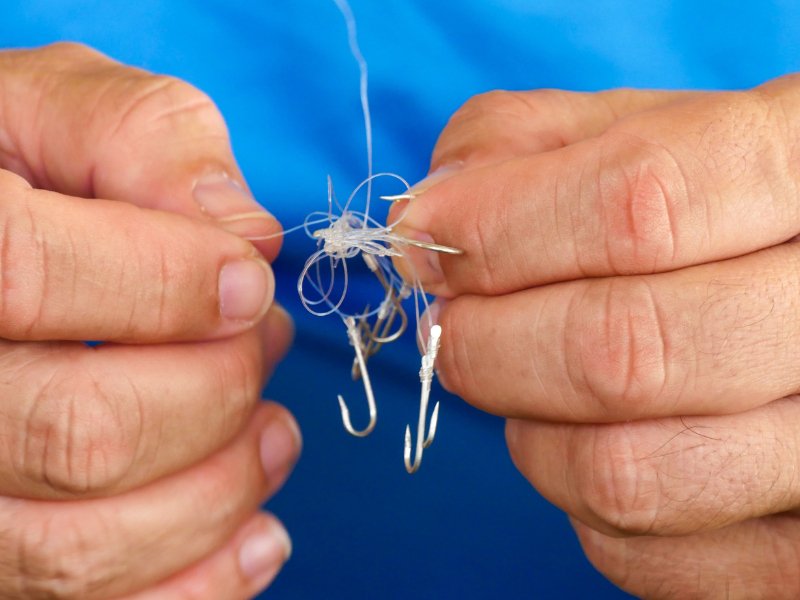
The Best Regular Fishing Lines For Fly Fishing
When you go fly fishing, certain lines will work better than others. Regular fishing lines are more inexpensive than those of specialty tippet lines, but the price will depend on the type of line you choose. You might find that some of the regular fishing lines might be more expensive. In addition, you should also consider what conditions you will be fishing in.
The Rio Gold Elite Is The Overall Best
The Rio Gold Elite fishing line is a great fly line and has a high recommendation. You can use the line for many fishing seasons continuously and to make drifts and accurately cast your lines. This fishing line is durable and affordable for most fishermen to use.
Rio Gold has many fishing lines to fit a range of fishing conditions and styles. The RIO Gold Elite is also a floating line that won’t let you down. The taper on the line will give you a great loop in longer distances since it is better than most average tapers.
The Orvis Clearwater Is Great For Sinking
The Orvis Clearwater fishing line is the best option when fishing in rivers and lakes with deep bodies of water. This line has an above-average IPS rating of 1.25. It is a fishing line that performs great since it sinks fast in most waters and conditions you fly fish in.
The line is affordable and commonly available at most online and local bait and tackle shops. The line has a welded loop, which ensures excellent and quick leader changeouts. Anyone looking for a fast sinking line must have this in their tackle box.
The second Choice Option Is The Scientific Anglers Frequency
When you are looking for an affordable but reliable regular fishing line to use as a tippet, you can use a Scientific Anglers Frequency line. This line is perfect for nymph and dry setups, making it great for fishing with trout anglers or smaller flies.
The weight of the taper is forward, but the origin company says it’s still versatile. While it is different, the line is similar to a WF and has a mid-length head, perfect for small dries and ultimate line control. Rest assured, you can get this fly fishing line for under $100 at your local bait and tackle shops.
The Rio Mainstream Saltwater For Salty Fly Fishing
The Rio Mainstream Saltwater fishing line performs excellently in any saltwater fishing conditions, as the name suggests. If you prefer to go fishing with one reel, then you can use the Rio Mainstream for any saltwater fish you desire to catch. The Rio Mainstream Saltwater fishing line is one of the best saltwater lines on the market now.
You can fish in all seasons with this line without worrying about cracks in the coating. The best place to fish with one of these lines is tropical temperatures since the coating is hard on the line. In addition, it won’t harden due to warm weather. With this line, you can throw heavy and oversized flies, which will turn over in the wind.
The Cortland 444 Is The Best Double Taper Fly Line
The Cortland 444 fishing line gives you an advantage with longer casts. You can use this line for fly fishing competitions where it will perform excellently. It will allow you the long casts with power behind them to help with any harsh weather like winds and rain.
The Tenkara USA Level Line Is The Best Level Taper
The Tenkara USA Level Line will allow you to throw streamers and other flies. This line won’t make a big splash when it lands, but it can be challenging to control. Tenkara has plenty of lines, but this one provides the best control and castability.
These lines work great for fishermen with tight budgets, but if you are new at the fly casting game, it’s best to steer clear since this line can become challenging to manage. In addition, you can also find these lines at most bait and tackle shops.
The Orvis Clearwater WF Line Is Best For Over Weight Flies
The Orvis Clearwater WF line is half a size heavier to aid in loading the rod to its maximum capacity. The small diameter of the line’s head allows for a high turnover rate, pinpoint casting, and fly placement.
The Clearwater WF line also includes incorporated slickness, providing for clear and smooth motion through the guides. The braided multifilament core makes fishing possible in nearly any environment. There aren’t a lot of lines available that can take the overload of weight on your rod.
The Scientific Anglers ST Is Great For Shooting Tips
The Scientific Anglers ST fishing line ensures longer casts and will entice fish to your fly. You can use this fishing line in fly fishing competitions where the longer casts will have power behind them, and you don’t have to worry about windy conditions during your fishing trip or competition.
Rio Perception Elite WF Best Weight Forward Line
The Rio Perception Elite WF is one of the best fishing lines when you need a weight-forward line on your rod. Many fishermen use these lines to catch trout and in river conditions. The Rio Perception line shoots out of the rod but will still land softly in the water and present your fly well.
This fishing line has no line memory, which is a great feature when fly fishing. You will have great control over the fishing line as well. In addition, the Elite WF fishing line is one of the top fly lines you can get, and Rio has also been a successful producer of many great fly lines.
Tips For Fly Fishing With Regular Lines As A Tippet
Fly fishing with a regular line requires skill, so you must know what materials to use and where to fish. Fishing in a spot clear of debris is a great start, but you will still need to know a few more facts before starting. Here are a few tips you can follow when you fly fish with regular fishing lines:
- Mind abrasion – Regular fishing lines may not be as abrasion-resistant as specialized tippet material. Be mindful of rocks, debris, and fish teeth that can fray or cut the line, and replace the tippet if it shows signs of wear
- Experiment with different line lengths – You can determine the presentation of your fly by the length of your line. Regular fishing lines have many lengths you can choose from, so you will have plenty of room to experiment and find the variation that best suits your fishing style. You can alter and adjust the line lengths to determine which length works best for you and the conditions you are fishing in
- Pay attention to visibility – Regular fishing lines can be more visible than specialty tippet lines. When you buy new lines, be sure to pick some that are clear and almost invisible
- Check knots and connections – The most essential part of fishing is to check your knots and connections before you cast your line. Loose connections and knots might cause you to lose your leader or miss a bite. You can check all the lines and other details at your fishing spot to make sure nothing else is loose
- Choose the correct line – Your line is one of the most critical parts of the rod. The correct line will help ensure you have the best chance of getting a bite. Select a fishing line with a diameter that is close to the size of the tippet you would typically use
- Use a leader – Attach a tapered leader between your fly line and the regular fishing line tippet. This attention to detail will help to turn over the fly more effectively and present it more naturally to the fish, which can lead to a higher success rate
Conclusion
In some cases, you can use a regular fishing line instead of a tippet, but you should balance the pros and cons before deciding. Standard monofilament lines are available in various diameters and strengths, whereas specialty tippet lines are stronger but require more maintenance. When selecting the best type of line for their specific situation, the decision ultimately boils down to the individual angler’s preferences and demands.
- What Size Baitcaster For Fishing Swimbaits? - February 8, 2024
- How Do You Mount A Fish Finder On A Float Tube? - February 8, 2024
- What Can I Use Instead Of Split Shot For Freshwater Fishing? - February 7, 2024





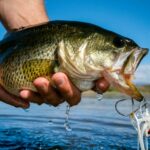
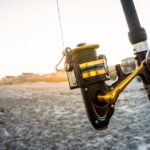
![Kayak Fishing for Beginners [10 Tips for a Successful Trip] fishing kayak moored on a beach](https://irvinelake.net/wp-content/uploads/2022/12/kayak-fishing-for-beginners-150x150.png)
